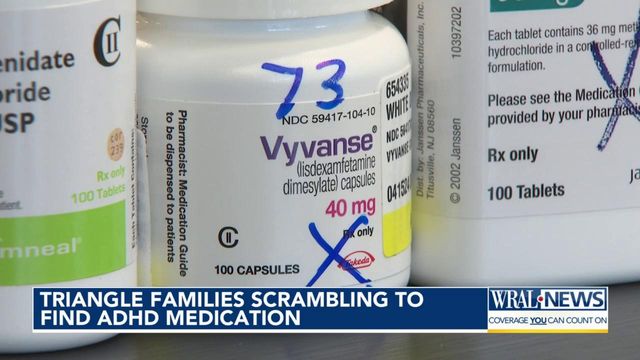NC parents struggling to find ADHD medication as drug shortages reach record high in US
Parents in North Carolina are feeling the strain of a national drug shortage of prescription drugs, including ADHD medication.
Kerry Caskey and her two teenage sons take medication for their ADHD and the shortage has affected all three of them.
“There are different shortages with different medications, and we take different medications,” she said. “We all have an issue with the medicines that we take.”
According to data from the American Society of Health-System Pharmacists and the University of Utah Drug Information Service, there are more active drug shortages in the United States than ever.
Along with 32 chemotherapy drugs in shortage, the five categories of drugs with the most shortages include central nervous system stimulants, antimicrobials, hormone agents and intravenous fluids.
Parents in North Carolina struggled with the shortage throughout 2023 and pharmacies have struggled to keep up with the demand.
Most insurance companies only cover the generic versions of Vyvanse and Focalin but do not cover the name-brand versions.
“It’s gotten better for some of the drugs,” Melissa Illig of White Oak Pharmacy said. “As far as Vyvanse, that has been a huge problem, especially since most of the insurance companies want to cover the generic, but we can’t get the generic.”
Caskey said not only is it getting harder to find the medication, but it’s becoming more expensive to do so.
“We pay $371 for a 30-day supply, so multiply that by three, and that’s what I’m paying every month for our medication,” she said.
Illig said continuing to pay out of pocket is not a sustainable strategy until the generic brands come back in stock. But parents like Caskey said they have to pay that bill if they or their children need the medication to function and feel like they are “at the mercy” of insurance companies.
“When I don’t have [my oldest son’s] medication, I get very worried. He can’t drive, he can’t work [and] he can’t go to school if he doesn’t have that,” she said. “It’s not just a school-day medication. It’s these kids' lives, and they depend on this to help them function.”
Largest drug shortage in a decade
The American Society of Health-System Pharmacists and the University of Utah Drug Information Service first started tracking drug shortages in 2001. Active shortages previously peaked in 2014, with 320 drugs in active shortage. Shortage levels have fluctuated in the decade, but have been steadily trending up since 2021 — reaching a record-high of 323 drugs in the first three months of 2024.
“It’s long past time to put an end to drug shortages,” Paul Abramowitz, chief executive officer of the American Society of Health-System Pharmacists, wrote in a blog post on April 11.
“All drug classes are vulnerable to shortages,” he wrote. “Some of the most worrying shortages involve generic sterile injectable medications, including cancer chemotherapy drugs and emergency medications stored in hospital crash carts and procedural areas. Ongoing national shortages of therapies for attention-deficit/hyperactivity disorder also remain a serious challenge for clinicians and patients.”
The drug shortage database maintained by the American Society of Health-System Pharmacists and the University of Utah is based on voluntary reports from practitioners, patients and others that are confirmed with manufacturers. This list often includes more drugs than the number considered to be in shortage by the US Food and Drug Administration because it captures broader impacts on providers and patients.
The average drug shortage lasts about a year and a half, according to government data. More than half of the treatment shortages have persisted for more than two years, according to an analysis by health consulting firm IQVIA. And the average shortage affects at least half a million patients, many of them older adults, according to the US Health and Human Services Office of the Assistant Secretary for Planning and Evaluation, which shared its analysis with Congress in May.
Increased demand can play a role in drug shortages, as with recent shortages of weight loss drugs. But more often, manufacturing and quality problems, such as supply chain gaps and discontinuations, are at the root.
Earlier in April, HHS published a white paper outlining policy suggestions to help prevent drug shortages and mitigate vulnerabilities. Among the key recommendations are collaborations with manufacturers and hospitals that aim to bring transparency to the drug market and incentivize investment in resilient and diverse supply chains.
Illig said she is hopeful a generic version of the ADHD medications will become more available, which will help other families afford the medication and make shortages less frequent.
“It’s a cheaper alternative and once the generic is released, it should be provided to the patient because it’s equivalent, but it’s not available, so that’s a problem,” she said.
Caskey, however, said that generic medications are not a one-size-fits-all solution for everyone.
“The generics are not one-to-one for the brand,” she said. “I have had people in my group who have said generic vyvanse doesn’t work for them, even if they can find it.”
The American Society of Health-System Pharmacists also has “serious concerns” about parts of the HHS’ proposal, notably the financial penalties for hospitals that lack resources to comply with the recommendations.
“We all know that managing shortages isn’t enough and is not a sustainable solution to the worsening crisis,” Abramowitz wrote. “Much work remains to be done at the federal level to fix the root causes of drug shortages.”
CNN’s Jen Christensen contributed to this report.











